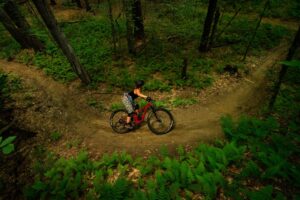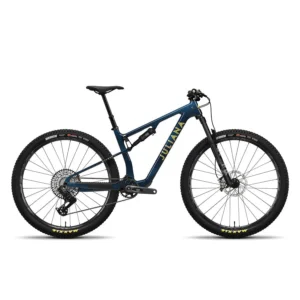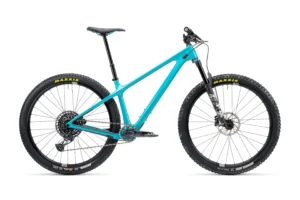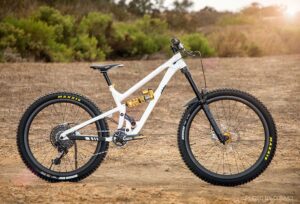You are ready to buy your first bike, yay! So where do you start….?
 Buying your first mountain bike can be a lot. This guide is designed to help you navigate what you need to know so you can be prepared when buying your first mountain bike. You do a Google search for “mountain bike,” and there is information overload! What information is good? How do you start to sift through all there is in the biking industry? As you begin to read about the different bikes you are learning, the biking industry has its own ‘lingo’, and it is easy to get lost amongst the linkage, wheel size, head tube angle, Eagle vs. XTR, and more. Buying your first bike can be an investment, and even if you’ve been riding a bike for years, it’s overwhelming. So let’s break it down so you can talk the talk and get on the bike that is right for YOU.
Buying your first mountain bike can be a lot. This guide is designed to help you navigate what you need to know so you can be prepared when buying your first mountain bike. You do a Google search for “mountain bike,” and there is information overload! What information is good? How do you start to sift through all there is in the biking industry? As you begin to read about the different bikes you are learning, the biking industry has its own ‘lingo’, and it is easy to get lost amongst the linkage, wheel size, head tube angle, Eagle vs. XTR, and more. Buying your first bike can be an investment, and even if you’ve been riding a bike for years, it’s overwhelming. So let’s break it down so you can talk the talk and get on the bike that is right for YOU.
Different Types of mountain bikes:
Wait, there is more than one type? Absolutely. We will discuss the several types of bikes, the components, the suspension, and travel.
Just like a car, a made-to-order meal, or even a dog, there are infinite types of mountain bikes from which you can choose! To decide which bike is the right one for you, you must ask yourself two important questions- what type of rider are you (or want to be), and where do you plan to ride? Generally, four main categories of bikes span the spectrum of mountain bikes.
- Trail
- Enduro
- Downhill
- Cross Country
Each bike is slightly different in terms of componentry and intended purpose, which leads us to different tire sizes, ‘suspension’ set-ups, and more!
Trail Bike: This is the one bike that has the capability to do a little bit of everything.! This bike can get you up and down nearly everything in Vermont. Trail bikes generally are full suspension (meaning both front and rear shocks) and have suspension travel ranging from 120-150mm. It hits the sweet spot between all other styles of bike. Your days may vary with this bike. You may spend one-day riding lifts at Killington, one day riding The Fairgrounds at Slate Valley Trails, and one day riding at Perry Hill in Waterbury. This bike is meant to handle it all with grace! This bike will allow you to climb your way up to the top and find the thrill you seek in your descent.
Cross Country (XC) bike: You want to go far and fast. This bike loves to climb. This type of bike is lighter than most and sets you up for a successful day in the saddle. This bike is fast, nimble and fun. Cross-country bikes have around 100-130mm of travel and can come as a full suspension or hardtail. It is designed for less techy trails, but don’t let the technology fool you- these bikes can handle a whole lot. You can climb anything with an XC bike, and it will set you up for cross-country or endurance racing. An XC bike is great for the day at Kingdom or any of the 900+ miles of singletrack in Vermont.
 Ambassador Jodie tip: I love my Julianna Wilder XC bike- she handles anything I put in front of her, and she is less than 25 lbs.)
Ambassador Jodie tip: I love my Julianna Wilder XC bike- she handles anything I put in front of her, and she is less than 25 lbs.)
Downhill: Vermont is home to some of the best lift-serve downhill mountain biking, and there is a bike meant for just that! Unlike the XC bike, the downhill bike is not meant for pedaling uphill (it’s super inefficient, that’s why there are lifts;]). With full suspension and a ‘dual crown’ front fork, downhill bikes are meant to absorb lots of rough terrain. With suspension ranging from 180-200 mm, this bike is designed for days of shuttling up and bombing down. The longer travel on DH bikes thrives when exploring big sends, doubles, rock gardens, berms, and drops. This is the queen bee for bike parks. Sure, this bike could manage the trails, but it likes downhill. It is built to descend. Its ergonomics make it less efficient for the climbs.
Enduro: The enduro bike is like a trail bike, but the rider’s mindset makes all the difference. If you like to climb but only enjoy the big downs with technical trails, big flowy berms, and more, the Enduro bike may be for you. Enduro bikes are full suspension with slightly more suspension than trail bikes, ranging between 140-170 mm. This is the in-between bike that can handle any techy single track and can stand its ground at any bike park. This bike has more pedaling efficiency to handle the climbs, yet it can handle the steep and techy downhills. This bike likes speed and will perform better if you let her ride. This bike provides the best for both worlds.
Suspension:
The suspension on your mountain bike can be the difference between an uncomfortable ride and a sweet, cushioned ride. Mountain bikes can come with either one or two suspensions. There are hardtails: front suspension only and full suspension: front and back. The suspension is the “cushion” to take on the force and rigidity when going over rocks, roots, or any obstacle the trail might have. Essentially, without going into physics- any force the bike is going over, for example, a rock garden- the force goes through the tire. Instead of moving it into your upper body, your front fork will absorb that energy. How cool is that?
Here is a little about both.
 Hardtail: Hardtail bikes have just that: a ‘hardtail.’ A hardtail has no suspension in the rear but does have suspension in the front! Just because they do not have two shocks doesn’t mean you should count them out. They are a fantastic ride for ALL riders and happen to be more wallet friendly. These bikes are great for climbs because you are not losing power in your shocks with each pedal stroke. They can be super affordable, and efficient, you’ll see them out on just about EVERY type of trail.
Hardtail: Hardtail bikes have just that: a ‘hardtail.’ A hardtail has no suspension in the rear but does have suspension in the front! Just because they do not have two shocks doesn’t mean you should count them out. They are a fantastic ride for ALL riders and happen to be more wallet friendly. These bikes are great for climbs because you are not losing power in your shocks with each pedal stroke. They can be super affordable, and efficient, you’ll see them out on just about EVERY type of trail.
Ambassador Jodie Tip: get a hard tail with a 27.5 + tire to make up for the no rear suspension. You will be able to ride the trails with your friends, and you may even be able to climb better.
Full-suspension: This bike has a front suspension fork and rear suspension shock. A full-suspension bike will help absorb the impact and reduce fatigue from the impact on the downhill and rough terrain. The rear suspension will provide more traction and control. Most of the bikes designed today can lock out both shocks to give you more pedaling capability on the climb.
Ambassador Jodie’s tip: If you lock out your suspension for long climbs, remember to unlock it on the way down. Trust me, we have all done it.

Travel:
 Let us talk about ‘travel’. What the heck is travel? Why should I know about it? Travel is a number that represents the force the suspension will absorb as you move through your flows and descent. If you have a full suspension, you will have dual suspension (front and back). The travel is measured in millimeters, equating to the amount of shock stanchions that move during compression. The higher the number, the more the shock can move and absorb force. For example, in a downhill bike, you want the bike to handle the jumps when you land, which is why they have more ‘travel.’ The bike takes the force, so your body does not have to. More travel doesn’t mean better…. Learn what you will be riding and then learn about travel.
Let us talk about ‘travel’. What the heck is travel? Why should I know about it? Travel is a number that represents the force the suspension will absorb as you move through your flows and descent. If you have a full suspension, you will have dual suspension (front and back). The travel is measured in millimeters, equating to the amount of shock stanchions that move during compression. The higher the number, the more the shock can move and absorb force. For example, in a downhill bike, you want the bike to handle the jumps when you land, which is why they have more ‘travel.’ The bike takes the force, so your body does not have to. More travel doesn’t mean better…. Learn what you will be riding and then learn about travel.
Frames:
Bikes are most commonly made from carbon or aluminum.
Carbon frames are going to be on the more expensive side of your bike purchase. Carbon frames are strong and low-weight, which bikers love and appreciate when moving the bike on the trails. Aluminum frames are a bit heavier but just as capable. There are options to find ‘high-end’ aluminum like platinum that will make it a bit lighter.
Tires:
Size: We’re talking about the diameter of the wheel. If you are coming from the road scene you may be more familiar with 700c, 650b, etc…. but on mountain bikes we’re talking 26”, 27.5, 27.5 + and 29” and of course, some fun combinations of the different sizes; a mullet: party in the front, style in back.
26: If you are running what you have right now, 26” tires used to be all the rage! They are nimble, easy to corner, and responsive. The only place they leave you asking for more is the force of rolling over larger features. They tend to get a bit ‘stuck.’
27.5: These tires are playful, responsive, and can whip it. These tires are great at accelerating and have decent traction. If you are riding trails requiring fine motor turning and good maneuverability, these are your tires. Just like the 26” tires, you may encounter some difficulty rolling over features.
29: The 29er is the most efficient tire: more surface area allows for better traction, it is great for rolling over rocks and roots, and it handles like a Cadillac. 29” tires can bomb through features no problem but do require a bit more effort on tight turns and fine-tuned skills
 The Mullet is 29” in the front and 27.5” in the rear. The mullet is here, and it’s cool (both bike and hairstyle) It does give you the best of both worlds – it allows for the responsiveness of the 27.5 and the rollover capability of the 29” tire.
The Mullet is 29” in the front and 27.5” in the rear. The mullet is here, and it’s cool (both bike and hairstyle) It does give you the best of both worlds – it allows for the responsiveness of the 27.5 and the rollover capability of the 29” tire.
Tube vs tubeless: What is ‘tubeless’ and why should I care? Tubes are great! They hold the air in your tires and keep you moving forward. When it comes to mountain biking, we want a lower tire pressure (PSI), so all of the knobs on our tires can get as much grip as possible! Low tire pressure tubes=pinch flats. Tubeless tires are set up to have no tubes but hold air thanks to sealant that sloshes around your tires. This allows riders to have lower, more supple tire pressure and not run the risk of flatting!
Ambassador Jodie tip: HIGHLY recommend tubeless tires = less flats
Drivetrain & Gears:
Drive trains are such a fun topic of discussion, and they can get complicated quickly. Let’s touch on what you should know, some terms you will hear, and some terms you should have a basic understanding of. The drivetrain is the “motor” of the bike. Like a car, you cannot go anywhere without a motor. The drivetrain moves your bike.
The components to make up your drivetrain are the crankset, bottom bracket, cassette, chain, and derailleurs.

Crankset: (Includes chainrings, and arm)
 The crankset is where the pedals connect to the bike. Depending on your setup, a bike can have, on average, 3 chainrings. On your new bike, you will hear ‘one by’ or ‘two by’… 1x is pronounced ‘one-by’, 2x is a two-by, etc. The first represents the number of chainrings in the front, and the second is the number of sprockets in the rear cassette, which provides you with the number of gears on your bike. A typical mountain bike is a one-by setup 1×10, 1×11, or 1x 12 there are some bikes (mostly gravel and road) that have a two-by system with two chainrings and a rear cassette. Most modern mountain bikes will have a 1×12 drive train. The crankset will determine how many gears you have in the front.
The crankset is where the pedals connect to the bike. Depending on your setup, a bike can have, on average, 3 chainrings. On your new bike, you will hear ‘one by’ or ‘two by’… 1x is pronounced ‘one-by’, 2x is a two-by, etc. The first represents the number of chainrings in the front, and the second is the number of sprockets in the rear cassette, which provides you with the number of gears on your bike. A typical mountain bike is a one-by setup 1×10, 1×11, or 1x 12 there are some bikes (mostly gravel and road) that have a two-by system with two chainrings and a rear cassette. Most modern mountain bikes will have a 1×12 drive train. The crankset will determine how many gears you have in the front.
Cassette: The cassette is connected to the back side of the bike. This will determine the gears in the back. The cassette has ‘cogs’ designated gears on the back of the bike. As I discussed in the crankset, if the bike is a 1 x 12, there is one chainring in the front and a cassette with 12 cogs in the rear.
has ‘cogs’ designated gears on the back of the bike. As I discussed in the crankset, if the bike is a 1 x 12, there is one chainring in the front and a cassette with 12 cogs in the rear.
Chain: The chain is the component that connects the chainring to the cassettes and moves your bike and creates the force of movement. It is the connector of your front gear to your rear.
Derailleur: The derailleur is the component that connects the chain to the rear cassette and moves the chain from one cog to the next. 
Ambassador Jodie maintenance tip: It is exposed. After an epic crash and you notice your chain is slipping, check to see if your derailleur is bent. A bent derailleur is a total bummer but can often be readjusted.
Drivetrain tip: It’s all about how ‘nice’ of a drivetrain you want. Do you want cable-actuated versus SRAM sick AXS electronic shift? What makes one drivetrain nicer than others? How efficiently it shifts! A good rule of thumb is that the more expensive it is, the better it’ll shift. That being said, less expensive drivetrains work perfectly, too!
Now that you know the ‘nuts and bolts’ of what you need to know when you are getting ready to buy a new bike, or maybe you are reading this because you want to understand what your bike is. Let’s shift gears and talk accessories.
Accessories:
What accessories should I be thinking about when I buy a bike? What are you wearing when you ride and what do you need to carry with you? Your bike outfit, is known as your “kit.” Before you jump up on your bike be prepared and know what you need. Safety is important, but don’t forget the style sure can be fun.
What you will need:
Helmet- Get a helmet designed for mountain biking. You never know when you might land off your bike and protecting your head, well kinda important.
Riding gloves– you can pick any fun style you want- there are so many styles, and it doesn’t matter what you get. The goal is to help with grip on sweaty, wet rides.
Riding shoes and pedals- You would think- wow my bike should come with pedals! Just like any other custom purchase, everyone has their own preference. You’ll get to decide between clipless (funny name because you actually CLIP IN) which allows for more force when pedaling upwards and flat pedals, which are just that- flat. Flat pedals have spikes all over them for traction, so watch out for your shins!
everyone has their own preference. You’ll get to decide between clipless (funny name because you actually CLIP IN) which allows for more force when pedaling upwards and flat pedals, which are just that- flat. Flat pedals have spikes all over them for traction, so watch out for your shins!
There are two types, clipless shoes, and flat shoes.
Ambassador Jodie tip: Unless you’ve been riding clipless on other bikes, starting with flats is a good rule of thumb (the bottoms are flat and grippy, so it is easy to step off and adjust your feet). You can’t go wrong with five tens, great riding shoes: clipless or flat.
Water Bottle or hydration system- Don’t forget you are exercising and need to be hydrating yourself! Whether you are rocking a Bivo bottle on your bike, a Thule backpack with a water reservoir or something else, always make sure you have enough water! You will need a cage for your frame to hold your water bottle.
Ambassador Jodie tip: For long rides, plan to drink 8oz every 20 minutes or so. Over an hour of ride, replenished with some electrolytes.
Riding glasses– my advice is to get yourself some sweet riding glasses, trust: you don’t want a bug to fly in your eye on the descent. (it’s technically protein if you swallow it!)
 Tools- You don’t want to find yourself out on the trail with a flat tire, any minor issue with your bike, or anything else! Buy yourself a multi-tool, and carry it on your ride with you. A tire puncture tool. Air-Co2 can make your life easy. Walking out isn’t fun.
Tools- You don’t want to find yourself out on the trail with a flat tire, any minor issue with your bike, or anything else! Buy yourself a multi-tool, and carry it on your ride with you. A tire puncture tool. Air-Co2 can make your life easy. Walking out isn’t fun.
Cleaning: Cleaning your bike is part of good maintenance. Get yourself a bike wash kit, which includes bike soap, degreaser, and lube. With your VMBA membership, you can get a discount at your local bike shop for accessories.
Wrap up:
You are now prepared to head out to buy your first mountain bike!
If you are still feeling overwhelmed but don’t know where exactly to start? Go to your local bike shop and rent a bike for a few hours to try em’ out. Learn about what trails you will be riding the most and start exploring. Trying different bikes will help you learn your style, and sometimes, the bike will choose you. The bike community loves bikes and loves talking bikes, so don’t feel intimidated to reach out to your VMBA ambassadors, bike shops, or any biking community. It is such a great community.
Ambassador Jodie Tip: Did you know that with a VMBA membership you can get rad discounts to get you on the trail with all the accessories you need? Plus discount on trailforks app membership!
I AM SO EXCITED FOR YOUR NEW BIKE DAY: take your Mandatory “new bike day” selfie and tag me @ Jodie-Maxine on insta and VMBA @vmba802
Have fun, ride safe.
About the author: VMBA Ambassador Jodie Legacy, a lover of bikes, 
When she is not riding bikes, she is practicing medicine,
home with her two dogs:
Roxy and Sarge and her pride and joy,
Her 14-year-old son Noah.
